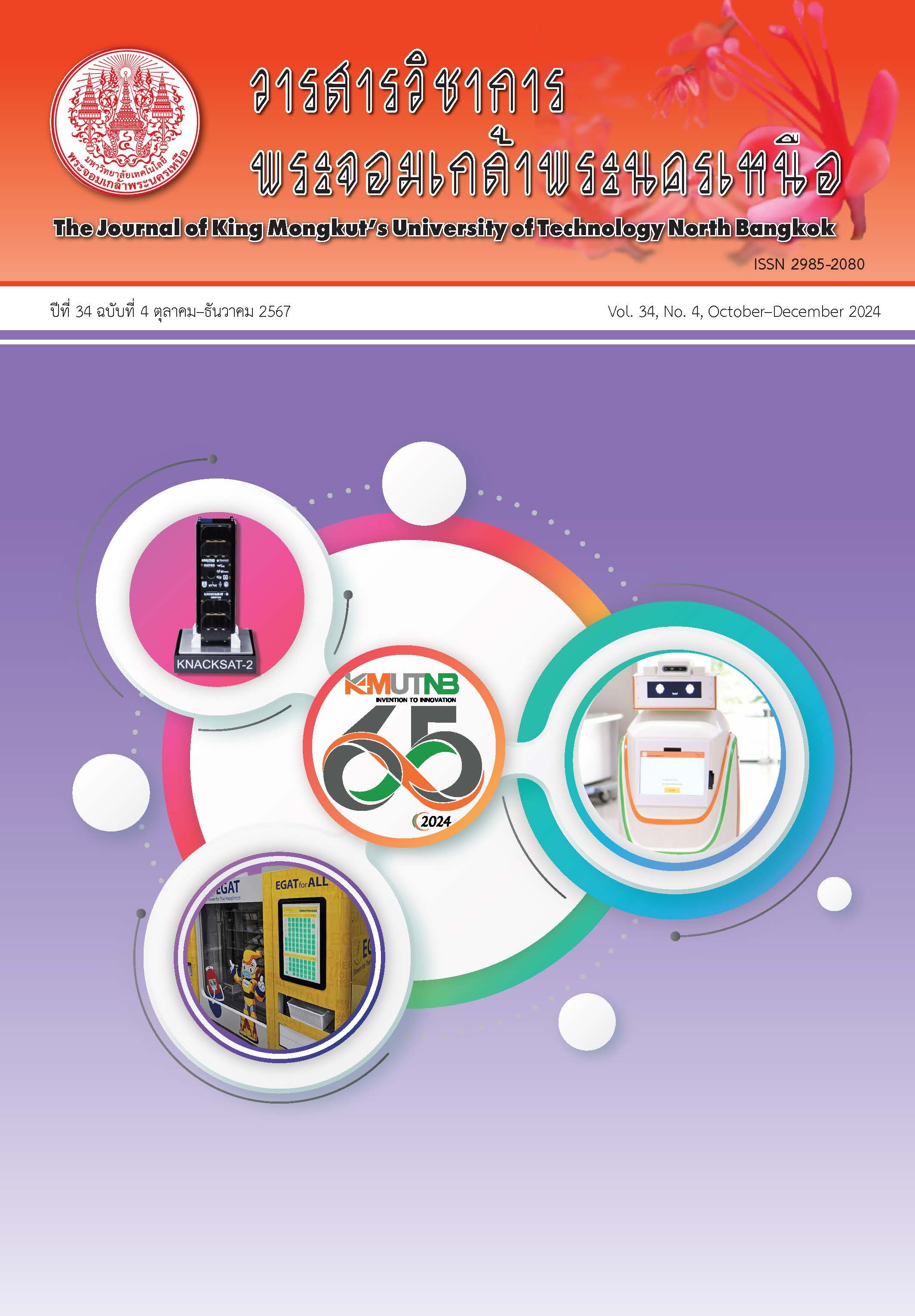สมบัติทางวิศวกรรมและการชะละลายโลหะหนักของมอร์ตาร์ปรับระดับผสมร่วมขากแผงวงจร อิเล็กทรอนิกส์แทนที่มวลรวมละเอียด
Main Article Content
บทคัดย่อ
ปัจจุบันขยะจากอุปกรณ์ไฟฟ้าและอิเล็กทรอนิกส์ที่หมดอายุการใช้งานได้กลายมาเป็นปัญหาขยะที่เพิ่มขึ้นอย่างรวดเร็ว โดยเฉพาะขยะจากซากแผงวงจรอิเล็กทรอนิกส์ซึ่งยากต่อการกำจัด ดังนั้นงานวิจัยนี้จึงเลือกใช้ซากแผงวงจรอิเล็กทรอนิกส์ส่วนที่เป็นอโลหะ ซึ่งเป็นขยะเหลือทิ้งจากกระบวนการแปรใช้ใหม่โดยวิธีทางกายภาพมาใช้ในงานผลิตมอร์ตาร์ปรับระดับ กำหนดสัดส่วนผสมของมอร์ตาร์โดยการนำซากแผงวงจรอิเล็กทรอนิกส์มาทำการแทนที่มวลรวมละเอียดอัตราส่วนร้อยละ 2.5–20 โดยน้ำหนัก ทำการทดสอบสมบัติทางกายภาพของซากแผงวงจรอิเล็กทรอนิกส์ สมบัติของมอร์ตาร์ในสภาวะเหลวและสภาวะแข็งตัว สมบัติการเป็นฉนวนกันความร้อน การวิเคราะห์สารประกอบด้วยรังสีเอ็กซ์และพฤติกรรมการชะละลายโลหะหนักของมอร์ตาร์ปรับระดับผสมร่วมซากแผงวงจรอิเล็กทรอนิกส์ ผลการทดสอบพบว่า ลักษณะการกระจายตัวของซากแผงวงจรอิเล็กทรอนิกส์มีค่าใกล้เคียงกับมวลรวมละเอียด ส่วนความถ่วงจำเพาะและความหนาแน่นต่ำกว่ามวลรวมละเอียด มอร์ตาร์ปรับระดับมีแนวโน้มความต้องการน้ำในส่วนผสมและระยะเวลาการก่อตัวเพิ่มขึ้นตามร้อยละการแทนที่มวลรวมละเอียดด้วยซากแผงวงจรอิเล็กทรอนิกส์ที่เพิ่มขึ้น ในขณะที่ความหนาแน่นและการพัฒนากำลังอัดมีแนวโน้มลดลง มอร์ตาร์ปรับระดับมีสมบัติความเป็นฉนวนที่ดี ส่วนการชะละลายโลหะหนักที่ปะปนอยู่ในซากแผงวงจรอิเล็กทรอนิกส์มีค่าอยู่ในเกณฑ์มาตรฐานกำหนด การพิจารณานำมอร์ตาร์ปรับระดับไปใช้งาน ปริมาณที่เหมาะสมสำหรับการผสมร่วมซากแผงวงจรอิเล็กทรอนิกส์ไม่ควรเกินร้อยละ 15 สำหรับการใช้งานเทรองพื้น และไม่เกินร้อยละ 7.5 สำหรับงานเททับหน้า
Article Details

อนุญาตภายใต้เงื่อนไข Creative Commons Attribution-NonCommercial-NoDerivatives 4.0 International License.
บทความที่ลงตีพิมพ์เป็นข้อคิดเห็นของผู้เขียนเท่านั้น
ผู้เขียนจะต้องเป็นผู้รับผิดชอบต่อผลทางกฎหมายใดๆ ที่อาจเกิดขึ้นจากบทความนั้น
เอกสารอ้างอิง
Self-leveling Mortar, TIS 3057, 2020 (in Thai).
Z. Zhao, J. Xiao, Z. Duan, J. Hubert, S. Grigoletto, and L. Courard, “Performance and durability of self-compacting mortar with recycled sand from crushed brick,”Journal of Building Engineering, vol. 57, no. 1, 2022.
T. V. Oliveira, L. N. P. Cordeiro, and S. A. L. Bessa, “Experimental study of self-leveling mortars produced with recycled concrete aggregates,”Case Studies in Construction Materials, vol. 17, no.1, 2022.
S. Candamano, F. Tassone, I. Iacobini, F. Crea, and P. D. Fazio, “The properties and durability of self-leveling and thixotropic mortars with recycled sand,” Applied Sciences, vol. 12, March 2022.
A. Vilaivong, S. Naenudon, A. Wongsa, V. Sata, and P. Chindaprasirt. “Properties of mortar incorporating fiber cement roof tile waste fine aggregate,” The Journal of KMUTNB, vol. 32, no.1, pp. 97–107, 2022.
L. N. A. Iniyan, and M. Shanmugasundaram. “Utilization of waste printed circuit boards as partial replacement for fine aggregate in concrete,” PAIDEUMA Journal of Research, vol. 3, pp. 28–32, 2010.
S. S. B. Mohamad, “Potential reuse of recovered nonmetallic printed circuit board waste as sand replacement in construction materials,” M.S. thesis, Civil Engineering, Universiti Teknologi Malaysia, Johor Bahru, 2014.
E. L. Schneider, H. M. Veit, W. L. Hartmann, C. M. Stolz, L. C. Robinson, C. T. Oliveira, and A. S. Vargas, “Cement matrix containing lightweight aggregates based on Non-Metallic Fraction Printed Circuit Boards (NMFPCB’S),” Journal of Materials Research and Technology, vol. 14, pp. 2992–2997, 2021.
P. Pianchaiyaphum, S. Kwonpongsagoon, P. Kanchanapiya, and C. Tuakta, “Recycling of non - metallic residue from waste printed circuit boards to produce interlocking concrete blocks,” International Journal of Environmental Science and Development, vol. 12, no. 6, pp.169–174, 2021.
Portland Cement, TIS 15, 2004 (in Thai).
Standard Specification for Portland Cement, ASTM C150, 2012.
Standard Specification for Standard Sand, ASTM C 778, 2002.
Standard Specification for Chemical Admixtures for Concrete, ASTM C 494, 2017.
Standard Test Method for Self-leveling Mortars Containing Hydraulic Cements, ASTM C1708, 2016.
Standard Practice for Mechanical Mixing of Hydraulic Cement Pastes and Mortars of Plastic Consistency, ASTM C305, 2006.
Standard Test Method for Compressive Strength of Hydraulic Cement Mortars (Using 2-in. or [50-mm] Cube Specimens), ASTM C109, 2007.
Characterization of Waste Leaching Compliance Test for Leaching of Granular Waste Materials and Sludges, BS EN 12457, 2000.
European Quality Assurance Scheme for Compost and Digest, EU: ECN – QAS, 2014.
Soil Quality Standard, Announcement of the National Environment Board, 2021 (in Thai).

